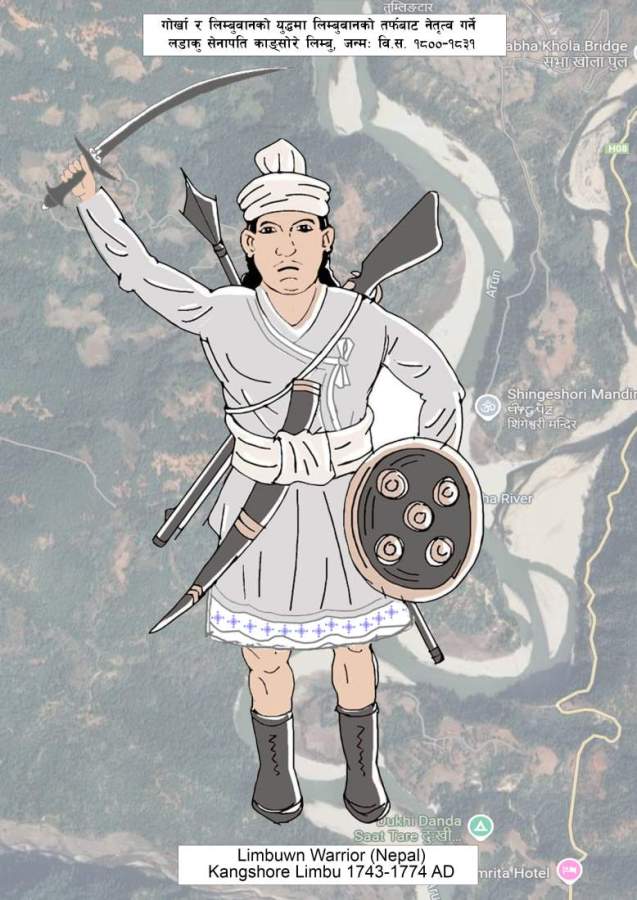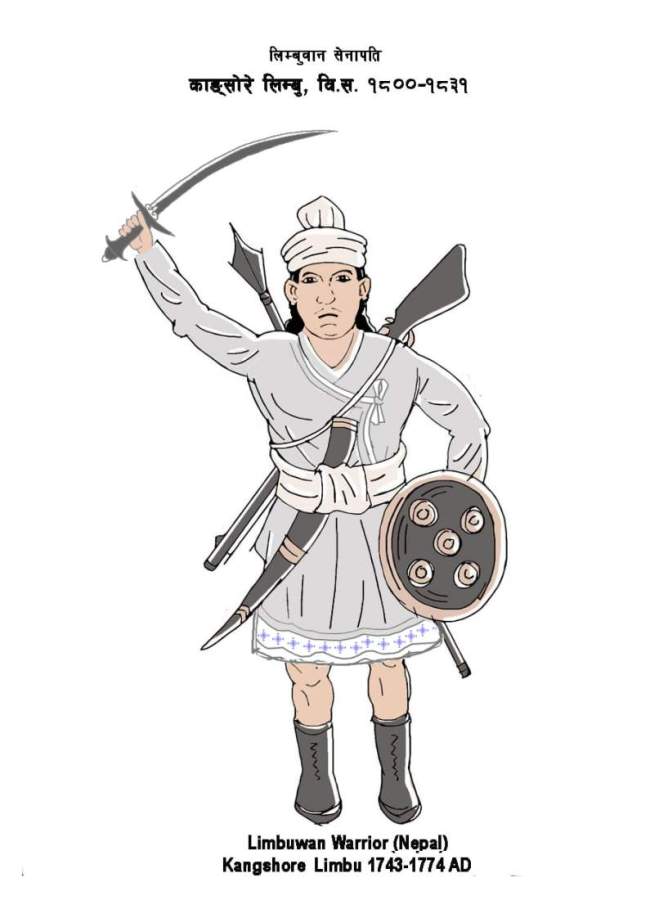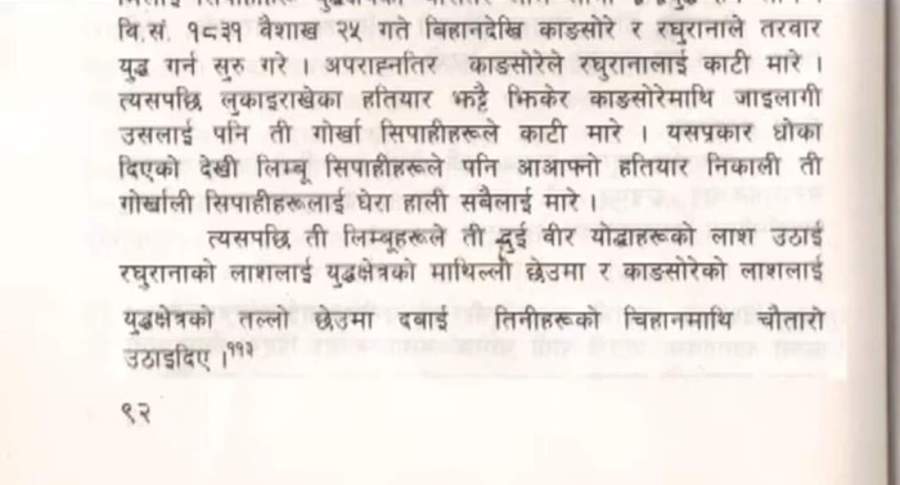

Barely half a decade after Buddhi Karna Khewahang seized the throne of Vijaypur, the king of Gorkha, Prithvi Narayan Shah, decided to launch an attack on Limbuwan. To counter the Gorkhali forces, a strong army was needed, so King Buddhi Karna entrusted the critical responsibility of commander-in-chief to his own uncle, Kangshore, considering him brave, skilled in warfare, and a close family member.
While the war was ongoing between the forces of Khambuwan and the Gorkhalis, the Limbuwan troops east of the Arun River had already made substantial preparations for battle. Crossing the Arun River was not an easy task for the Gorkhali soldiers. Many battles were fought across various villages along the Arun River, which flows towards Chatra via Sabha Dobhan. Under the direct command of Kangshore, the Limbuwan forces won over seventeen battles.
According to manuscripts compiled by historian Hodgson, Kangshore’s troops chased the Gorkhalis as far as Chainpur, Jhangajholi, Dumja (Sindhuli), Bahrabise, Dolakha, and Ramechhap — all eight days’ journey from Sabha Dobhan via Arun Sabha Dobhan. They inflicted severe defeats on the Gorkhali forces. Later, Prithvi Narayan Shah dispatched Commander Raghu Rana to attack again. But once again, the Gorkhali army could not prevail. Ultimately, it was agreed that only the two commanders-in-chief from both sides would fight each other with swords and shields to determine the victor.
Following the terms, Commander Kangshore arrived at the battlefield without any other weapons, accompanied by his soldiers. A fierce duel ensued between the two commanders. Blessed with remarkable prowess, Kangshore killed the Gorkhali commander Raghu Rana with his sword. However, the cunning Gorkhali soldiers, skilled in trickery, unearthed hidden weapons buried in the ground and killed Commander Kangshore.

The bodies of both commanders were buried with great honor near Sabha Dobhan—Raghu Rana’s remains were interred at the upper edge of the battlefield at Gandhepani, while Kangshore’s were placed at the lower edge. Memorial platforms (Chautaras) were built over their graves (Chemjong, page 92).
These memorial sites can still be seen today, with both graves facing each other, one uphill and the other downhill. After the tragic and heroic death of Commander Kangshore, the responsibility of the second commander-in-chief passed to Mudimba Khewahang, who also attained martyrdom in the fierce battle at Chataraghat between the Limbu and Gorkhali forces.
Several battles took place between the Gorkhalis and Limbuwan in various locations, many of which were led by Commanders Kangshore and Mudimba Khewahang. The Gorkhalis suffered heavy losses in the war against Limbuwan, ultimately failing to conquer it by force and instead establishing diplomatic relations. A treaty was concluded at Bijaypur and Dharan, where the Gorkhalis swore an oath over salt and water (a traditional ritual), recognizing Limbuwan’s right to maintain its own currency and legal system. The autonomous Limbuwan state continued to have representatives stationed in Kathmandu until 1888 AD (Sambat 1945).
According to the book Manav Utpatti ra Khewa Bansh (The Origin of Humans and the Khewa Dynasty), published in 2055 B.S. (1998 AD), Commander Kangshore Khewahang was born in 1743 AD (B.S. 1800) in Tehrathum, Chhathar, Okhre, at a place called Khewahang Yak Taklung, as the eldest son of Hang Kamarai Khewahang. From a young age, he loved his community and land deeply. Hunting and swordsmanship were his passions. He also supported Buddhi Karna in ascending the throne of Vijaypur.
Fighting to defend the land of Limbuwan and its people, Commander Kangshore ultimately attained martyrdom on the 25th of Baisakh, 1774 AD (B.S. 1831). His descendants still reside near Sabha Dobhan, in Leguwa and Chhathar Hattikharka. Moreover, Khewahang families also live in Jarayotar of Bhojpur near Sabha Dobhan. This area marks the westernmost settlement of the Khewahang people. Historical records, including those of Iman Singh Chemjong and the scholar Dr. Harka Gurung, indicate that the Khewahang dynasty once ruled as far west as the Dudhkoshi River. However, during the Sen period, when Lohang Sen divided his provinces and set the Arun River as the boundary, the Khewahang’s territory up to western Dudhkoshi was lost. Commander Kangshore Khewahang (also known as Kangso Rai), along with the second commander Mudimba Khewahang and other valiant heroes, became enduring sources of inspiration for their unparalleled contributions in defending Limbuwan.
In memory of Commander Kangshore, the Limbus of Chhathar organized the Kangsowa Fair. The fair used to be held until 2001 AD (B.S. 2058) at the tail end of the Teliya Khola in Chhathar, a place still known as Kangsowa today. The river formerly known as Teliya Khola was once entirely called Kangsowa Khola because Kangshore used to hunt and train for battle there. However, in 1818 AD (B.S. 1875), a temple built of Teliya bricks was named Tileshwar Mahadev Temple, leading to the river being renamed Teliya Khola. Similarly, Khamnira village, whose name came from the Limbu language, was renamed Teliya. In Chhathar Okhre, there is still agricultural land held in the name of Kangshore.
When additional troops from Taklung were marching toward Sabha Dobhan to aid the valiant Commander Kangshore, they received news of his death upon reaching a river that marked the border between Hamarjung and Angdim VDCs. When asked on which day Kangshore was killed, the soldiers replied “Lawa Pambam Ain,” meaning “the night when the moon shines brightly in the sky.” Hence, the river retained the name Pambam Khola, by which it is still known today.
In memory of the brave Commander Kangshore, both the river and the fair were named Kangsowa. Directly opposite the site of the Kangsowa Fair lies Hangsamorong, where a temple of Lord Kailash Shiva has been established, and a Shivaratri (Seurati) fair is held annually. In history, Limbuwan’s people have always remembered their courageous commanders Kangshore, Sangbotre, Tesakpa, Sipa, Phakte, Mudimba, and others with great respect and pride.
The Khewa genealogical record was published in 1998 AD (B.S. 2055). It was only around 2005-2006 AD (B.S. 2062/63) that discussion about Kangshore began to rise prominently. His name appears in the genealogical records, but there was debate among authors about who originally documented his name. Eventually, Limbu historian the late Bharat Tungghang revealed that the late Subba Hridya Man Limbu had handed him notes in B.S. 2052 (1995 AD), clarifying that Hridya Man Limbu had recorded Kangshore’s name. Sadly, Limbu passed away just a few weeks before the genealogy was published. Following the surge in discussions about Kangshore, the Phago Chongwang and Wanem clans also began to claim connections to him. Diverging claims about historical figures are considered normal in history. That Kangshore was a Limbu is undisputed; however, which particular clan he belonged to remains under debate. Since the tombs of Kangshore and Raghu Rana mentioned in Iman Singh Chemjong’s History of Vijaypur in the Kirat Period still exist, it has been proposed that carbon dating and DNA testing could help resolve these questions.
In 1774 AD (B.S. 1831), some Limbu leaders signed a treaty, while others continued fighting. Limbu factions from Chhathar, Yangwarak, Chainpur (Jasmukhi), the Arun Valley, and the Lingtheps continued the resistance under the leadership of Buddhi Karna Khewahang. Historical records also show that leaders like Sirdeu Phango, Rainsing Libang, and Atahang of Phedap supported the Gorkhalis — essentially, some Limbus themselves sided against Limbuwan. Even prominent figures like Kum Rai, Sun Rai, and Jung Rai are recorded as having assisted the Gorkhalis during the negotiations. Eventually, Buddhi Karna, who kept leading the resistance even after the treaty, was captured in 1777 AD (B.S. 1834) at a place called Company Territory Chilimari and brought to Vijaypur, where he was tortured for three days and killed. Of the wars that lasted seventeen years (1774–1791 AD / B.S. 1831–1848), the battle at Siddhipur (Sankhuwasabha) was the last significant one. After that victory, the Gorkhalis extended their control through Yangwarak Hilla Hang into Islimba and Chyangthapu in Panchthar.

Because Commander Kangshore is such an important figure in Limbuwan history, he should be regarded as a shared heritage of all of Limbuwan, not belonging solely to any particular clan. Let us always remember his contributions and, invoking Kangshore’s blessings, remain committed to the ongoing efforts for the restoration of Limbuwan. Jai Kangshore!
Sources:
A Concise History of Contemporary Vijaypur – Iman Singh Chemjong, pages 111, 92
Divya Meru Manas Samaj – Capt. Gopilal Limbu, page 45
Manav Utpatti ra Khewa Bansh (2055 B.S.), page 49
Shrinkhala – Writer Lokendra Tigela, page 86
Nepalisamachar.com
Nepaliliterature.com
Sanghiya, monthly
Buddhi Karna and Kangshore Conservation Foundation
Hamilton, An Account of the Kingdom of Nepal
Mundhum scholar Bharat Tungghang and journalist Bhairav Angla
Lamichhane, Tika Prasad, Purwanchal ma Dhankuta, Publisher Pallabh Sahitya Pratishthan, Narayanghat, Chitwan 2068 B.S.; printed by Gajarmukhi Offset Press, Biratnagar
Comment